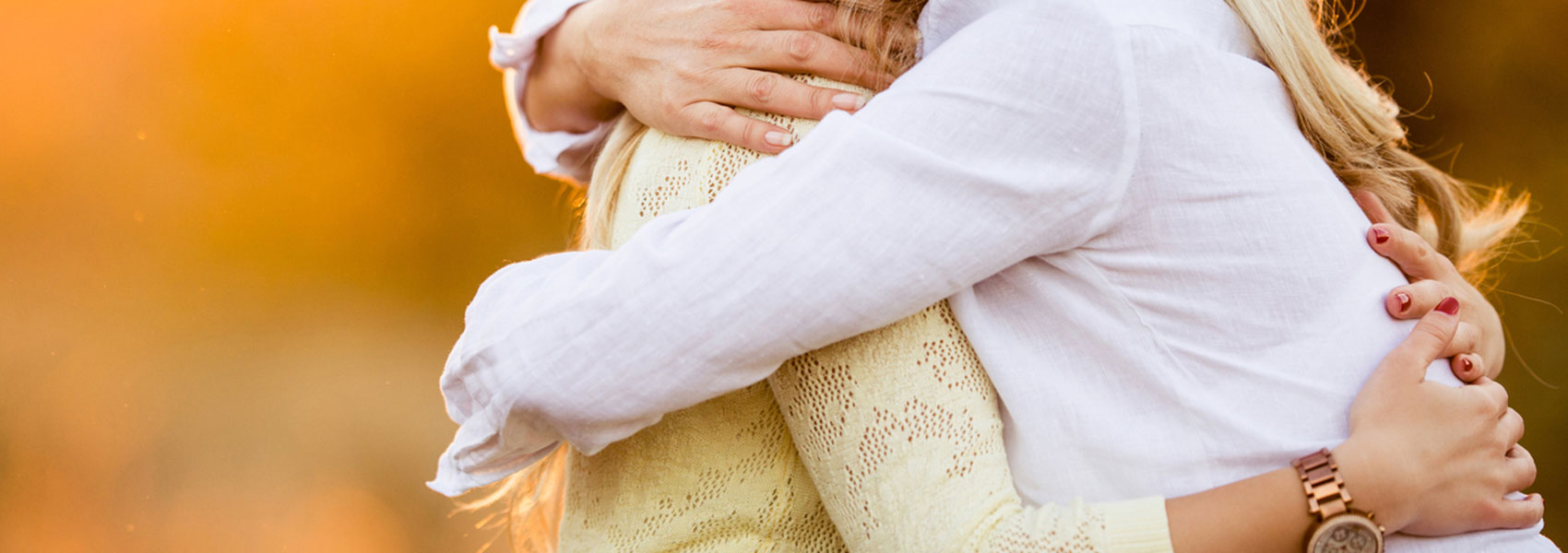Falling in love with Mallory
When Lisa Marie adopted Mallory, a teenager in foster care, Lisa Marie realized there was no guide for how to fall in love with her daughter.
Lisa Marie G, adoptive parent

EDITOR’S NOTE: Lisa Marie wrote and shared this story with Bethany in 2016. In 2021, Lisa Marie and Mallory established the Grace Fund to help more waiting teens find an adoptive family. Contact us to learn more about the Grace Fund, or click here for a Q&A with Mallory about her memories from this transformational time.
"Ready!” I called over my shoulder to Mallory without fully pivoting or looking down. I knew she was on the ground, even though I couldn’t see her.
“Okay, Mom!” She capably released the rope through the belay, smoothly lowering me from my three-story ascent. She had encouraged me to climb another of the routes on the indoor wall—“You go now,” she said. “You can do it, Mom!”—mirroring my encouragement and selflessness in taking turns.
I fell in love, again, this time with her competency and self-assurance. When I expounded later how safe I felt with her belaying me, she asked me to say more.
“I knew you had me,” I said. “I knew you knew how to work the belay. I trusted you.” She let my words fall warmly over her, like sunlight.
Developmentally, foundational trust builds between mothers and infants from birth until the age of 2. Baby and mommy lock eyes, coo, and giggle, with mommy providing the soothing touch and meeting baby’s basic needs. Emotionally, baby attaches and mommy bonds. Simply put, they fall in love with each other.
None of the books I read about adopting an older child offered guidance on how to fall in love with a teenager. I’d studied attachment parenting, but I’d never made the leap from the intellectual task to the emotional task. I hadn’t considered how I would come to love a teenager from scratch.
Falling in love is a dance
Early in her placement with me, Mallory sometimes asked me to tickle her. One of these times, she giggled and squirmed as usual and then looked into my eyes with pure love and innocence. She had the look of a much younger child. Her biological mom had tickled her, and Mallory trusted me with this joyful, intimate experience.
That day, I fell in love with her young hunger to be cherished. Her need for me to delight her and delight in her was so deep, she overlooked the fact that she was 14 years old. I glimpsed the child I missed knowing, tucked inside her.
I fell in love with Mallory the first time we made homemade pizza dough. As the KitchenAid mixer whirred, she burst into song:
We’re gonna take a trip on a big rocket ship
Sailing through the sky, Little Einsteins
Climb on aboard, get ready to explore!
Now, every time we make pizza dough, the experience is rounded with this happy memory. These days, she is more likely to set a Josh Groban station on Pandora or belt out an Adele song, and I’m left reeling yet again. No one prepared me for how fast she would grow up or how a compressed, accelerated growth spurt would leave me breathless.
Even before placement, during the weekend I flew to Texas to meet her, I was learning how to be a mom to the whole of her. I fell in love with the way she dove under the water in the tiny hotel pool, her body craving the comfort of water in a way I completely understood.
I fell in love with the way she pressed her hands clumsily against mine, yearning for physical contact but inexperienced at it. I fell in love with her courage that Saturday when she told me in the rental Jeep she wanted to change her last name to mine.
This dance of attachment and bonding hasn’t always been so poetic. I also fell in love with Mallory when she threw a piece of half-eaten cinnamon toast at me as she stormed out of the car.
When she hurled clementines in the kitchen, carefully missing me but clearly satisfied with how their popping and splattering expressed her anger.
When she both shoved me and clawed to embrace me, her arms again wild, her whole body and heart ambivalent, furious, and desperate to keep me.
I fell in love with her the evening she turned away from me in the car, her face expressionless, her demeanor ashamed, after a forced therapy session. When I chose compassion rather than frustration, I turned a corner in becoming the mother Mallory needed, not the well-meaning mother people encouraged me to be.

Falling in love is dangerous
For most teenagers, falling in love is awkward. Mallory was 7 when she’d been separated from her mother, and she spent the next seven years in foster care. She experienced a devastating disrupted adoption and was unfairly labeled as a result of the many traumas she’d endured. She ultimately spent six months in a residential treatment center surrounded by barbed wire—forced to earn her way out through good behavior. For this girl, falling in love was dangerous.
People tell me I’m brave for adopting Mallory. They tell me I’m a saint, that I’m saving her, that what I’m doing is “amazing” and “incredible.” These superhero words float in the air like cartoon lettering in a comic strip fantasy.
Mallory is my daughter. She was my daughter from the moment I saw her photograph on an adoption website and had no certainty, but a strong intuition, that she would be in my life.
“How did you find me?” she asked, incredulous. “I saw that website, and my picture was way on the bottom of the page. I didn’t think anyone would ever find me.”
“Well, I found you,” I answered. “That page did load slowly, and your profile was way at the bottom. But I’m very thorough.”
Last New Year’s Eve, one year and one month from when I first saw Mallory’s photograph, both of us still giddy from finalizing in December, I sat on the edge of her bed to say goodnight. “That was a fun day,” I said. We had ice-skated and then watched the television special of the concert, the countdown, and the ball dropping in Times Square. The living room was littered with confetti from the six poppers we popped in celebration.
“Yeah,” she said. “And you were even annoyed with me today.” New Year’s Eve was the first time she realized that seemingly conflicting emotions don’t cancel out enduring love. “And now I’m your child!” she exclaimed, her arms outstretched for a hug. Her familiar and endearing innocence shone yet again.
Falling in love takes trust
On the surface, falling in love seems more appropriate for infants and moms—or at least easier to discuss. As with most developmental milestones, those our adopted older children reach are out of order, partial and seeking completion, and accomplished differently. It’s the same for the milestones we reach as adoptive moms and dads.
Although I’m not a psychologist, I would guess that trust is the first developmental milestone for infants and mothers for a reason: Everything else rests on it. How can we trust one another as mother and daughter without love? And how can we love partially, afraid to let the proverbial “other shoe” drop, when our situations begin in trauma, loss, and profound hurt, requiring us to be all in from the start?
Love has to come first. Before therapy, before house rules, before time-ins, I needed to offer Mallory eye contact, back rubs, hugs, and kisses. I needed to respond consistently and tenderly to her needs. I needed to climb back through the years that we didn’t have together, a seemingly impossible task. I needed to hold her, as best I could, in my literal and metaphorical arms. I also needed to take down my carefully built walls and let her come to know me, making space for her to love me in return.
Perhaps Mallory would say she fell in love with me when I screamed really loudly, at her request, just for the fun of it. Maybe it was the day I helped her dye her hair red or fielded all five-foot-seven-inches of her as she flopped her tall, strong body over me and hugged me unabashedly.
Maybe it was the time I pretended to be able to pick her up and carry her to bed, imagination offering the only way to accommodate her heartfelt request. Or the first time I said “I love you” back to her in precisely the way she needed to hear it.
I knew for certain she fell in love with me, again, when I trusted her to lower me down the rock wall—a surprising reversal. Yes, I recognized the danger of trusting your whole self to another human being. And, yes, I was also brave enough to let her control the rope that caught me and brought me safely to the mat below where she was waiting.



